Leopard
for two players
|
I made some improvements in the original rules, which I’ll explain later in the section Notes on Changes. | |
| |
|
The players lay cards on the table to form two squares, one in front of each player. Each square has nine spaces, like a tit-tat-toe grid. A square is worth three points for every row, column, or diagonal that has three cards of the same suit showing, plus one point for every row, column, or diagonal that shows three cards of the same color but not of the same suit. Each player tries to build up the value of his square while keeping down the value of his opponent’s. His score for a hand of play is based mainly on what his square is worth at the end of the hand. | |
| |
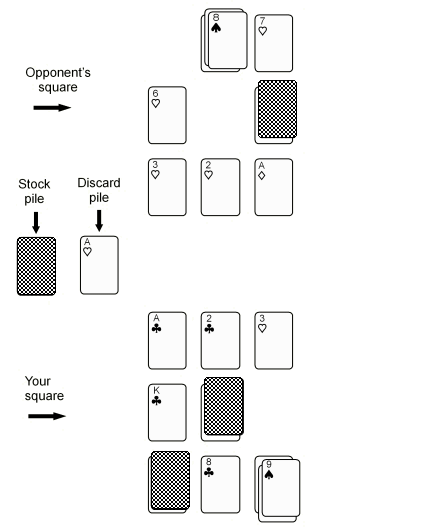 | |
| |
|
Two standard decks (104 cards) are used. The cards are cut for deal; the player drawing the highest card is dealer (ace is ranked low). If both players draw the same numbered card, they draw again. The deal alternates after each hand. Eight cards are dealt to each player. The remainder of the pack is placed on one side of the table to form the stock pile. The player opposite the dealer has the first turn. | |
| |
|
The following is a diagram of the layout. The nine spaces of each square are numbered as shown: 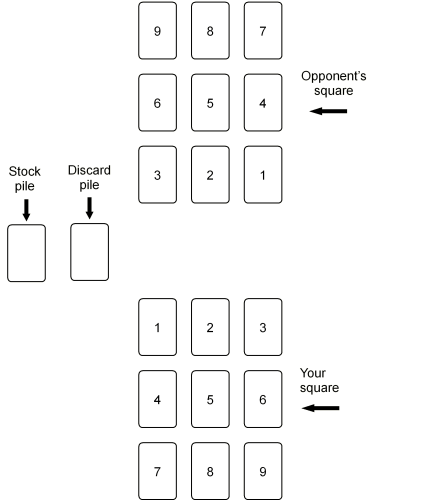 This diagram should be kept in mind, but it need not be marked on the table. The shape of the layout will become apparent after a few cards have been laid down. | |
| |
|
In his turn, a player first draws a card from the stock pile and adds it to his hand. He then has a choice either of discarding one card from his hand or of playing one card onto his square or onto his opponent’s square. After he plays, the turn passes to his opponent. A card that has been discarded or placed on a square cannot be picked up again by either player. | |
|
Various rules govern what cards a player may place on the different spaces of his square or his opponent’s square, when he may play a card on top of another card, and what cards are placed face down instead of face up. (Cards that are face down on a square do not have their suit or color showing and thus are not counted as part of any scoring line. A space whose top card is face down is considered the same as a blank space and prevents the line from being complete for scoring.) The rules for the use of each card are given in the following four sections, and then these rules are summarized in a reference chart. | |
| |
|
Any of the cards ace through nine may be placed only on the space in either square whose number corresponds with the number of the card. That is, an ace may be placed only on the space numbered 1 in your square or on the space numbered 1 in your opponent’s square, the deuce may be placed only on the space numbered 2 in either square, etc. If no cards have as yet been played on your square and you decide to play there, for example a If the next card you play on your square is an 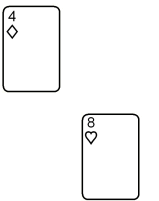 | |
|
If the next card is a 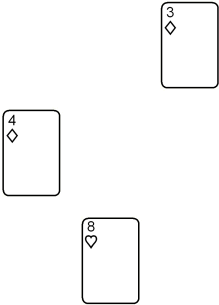 The cards ace through nine are placed face up; they go only in blank spaces or in a space whose top card lies face down. A player may place any of these cards on his opponent’s square as well as his own. If, as in the above example, you had played the 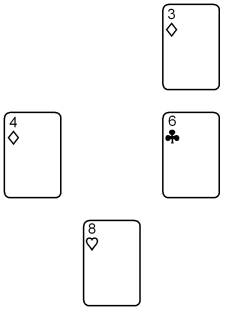 With this |
| |
|
A ten can be placed face up in any blank space in your square (or on top of any card in your square that lies face down). You may not play a ten on your opponent’s square. A ten is a valuable card to have if it is of the right suit or color. For example, suppose you had this square: 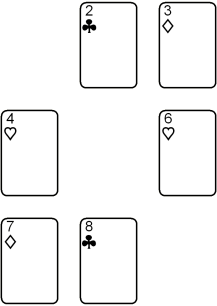 If you put a 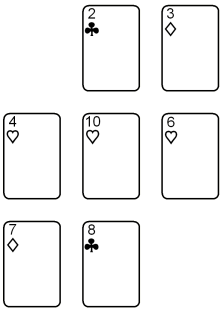 | |
|
the value of your square would now be 4 points — three points for the horizontal line If you play a ten when your square is only partially complete, there may be doubt as to what space you mean the ten to occupy. In this case you must declare what space you are putting the ten in. | |
| |
|
A king, if it is of the right suit or color, is the most powerful card you can have for increasing the value of your square. A king may be put on top of any card as well as in a blank space. You may place a king face up in any space in your square but not in your opponent’s. For example, the value of the following square in its present condition is 1 point (for the diagonal line of three black cards):  | |
|
A 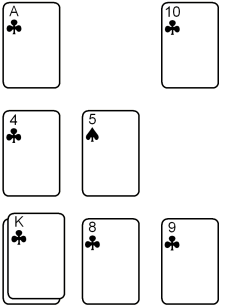 and the value of the square would be 8 points — three points for the horizontal As with the ten, if there is any doubt which space you mean a king to occupy, you must declare which space it is on. | |
| |
|
The jack and the queen can be thought of as portable blank spaces, since they are always played face down. It does not matter what their suits or colors are because they are not counted as part of any scoring line. And any card that can be played on a space that is blank can also be played on top of a jack or queen in that space. | |
|
You may play a jack face down on top of any card in your square or in your opponent’s square. This makes it an effective card for sabotage. Suppose your opponent had the following square, which has the value of 6 points: 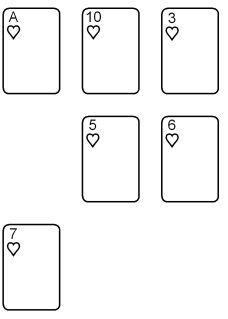 If you put a  the value of his square would now be zero. Any other jack could also have been put on the |
|
You may place a queen face down on top of any card in your square but not in your opponent’s. The following example will show the strategy in playing a queen or jack on your own square. Suppose you again had this square:  and in your hand you have a  |
|
After your opponent has taken his turn, you draw again from the stock pile and then play the 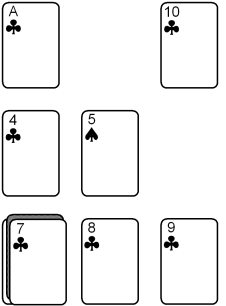 The value of your square has thus been increased to 8 points raw score. If your opponent had had another red seven, he might have put it on your It is usually the best strategy for a player to try to fill his square with cards of one color. However, he will sometimes find that, after laying a few black cards on his square, his hand contains mainly red cards. If his hand also contains enough queens or jacks, it may be to his advantage to use the queens and jacks to cover up some of the black cards and then to fill his square with the red cards. This process of changing the color of your square is called “changing your spots.” [Note to whoever is translating this game into Spanish: The name of this game came from the English expression “The Leopard can’t change its spots,” which means people can’t change. Is there a similar expression in Spanish? If not, you might want to mention that the name of the game came from that English expression.] When a jack or queen is discarded, it is placed face up on the discard pile, as are the other cards. |
| |
|
The rules that govern the use of different cards are summarized in the chart below. You might find the chart helpful when you try your first hand. | |
| A to 9 | Only in space of corresponding number | In either player’s square | Only in a blank space or on top of a card turned face down | Face up |
| 10 | In any numbered space | Only in own square, not in opponent’s | Only in a blank space or on top of a card turned face down | Face up |
| J | In any numbered space | In either player’s square | On top of anything | Face down |
| Q | In any numbered space | Only in own square, not in opponent’s | On top of anything | Face down |
| K | In any numbered space | Only in own square, not in opponent’s | On top of anything (or in a blank space) | Face up |
| |
|
A player has the option of going out if the value of his square is 7 points or more and if it is still his turn to play. That is, he can go out after he has drawn and before making any other play. He cannot go out immediately after having played or discarded a card. Therefore, suppose you have the following square, the value of which is 3: 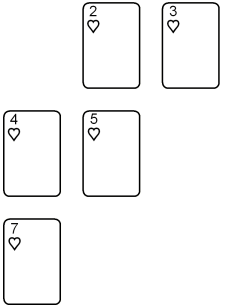 You draw an The player who goes out has one point deducted from his score for the hand. (in this respect Leopard differs from most games, which give a bonus for going out.) This is done to discourage players from going out too fast. | |
| |
|
When a player declares that he is out, the hand is complete. If neither player goes out before the stock pile is exhausted, the players continue playing in turn, either discarding a card or playing a card on one of the squares. If still no one has gone out when the last card is played, the hand is complete at that point (and neither player receives the one-point deduction for going out). | |
| |
|
When a hand is ended, each player’s score is figured as follows: First the raw score value is computed for the player’s square in the condition it is in at the end of the hand. As was said before, a square is worth three points for every line that shows three cards of the same suit plus one point for every line that shows three cards of the same color but not of the same suit. There are eight lines to a square, three horizontal, three vertical, and two diagonal. Next, a bonus of one point is added for every point the raw score is above 7. In other words, every point above 7 is doubled. The table below gives the value of the score with bonus for each corresponding value of the raw score: | |
| Raw Score | 1 | 2 | 3 | 4 | 5 | 6 | 7 | 8 | 9 | 10 | 11 | 12 | 13 | 14 | 15 | 16 | 17 | 18 | 19 | 20 | 21 | 22 | 23 | 24 |
| Score with Bonus | 1 | 2 | 3 | 4 | 5 | 6 | 7 | 9 | 11 | 13 | 15 | 17 | 19 | 21 | 23 | 25 | 27 | 29 | 31 | 33 | 35 | 37 | 39 | 41 |
| Raw Score | 1 | 2 | 3 | 4 | 5 | 6 | 7 | 8 | 9 | 10 | 11 | 12 | 13 | 14 | 15 | 16 | 17 | 18 | 19 | 20 | 21 | 22 | 23 | 24 |
| Score with Bonus | 1 | 2 | 3 | 4 | 5 | 6 | 7 | 9 | 11 | 13 | 15 | 17 | 19 | 21 | 23 | 25 | 27 | 29 | 31 | 33 | 35 | 37 | 39 | 41 |
|
Finally, one point is subtracted from the score with bonus if the player had gone out this hand. Thus, what a player scores for a hand of play is the raw score value of his square, plus a bonus on one point for every point the raw score is above 7, minus one point if the player had gone out. A game consists of four hands of play. The game scores of the players are totaled after each hand, and the one with the highest after the fourth hand is the winner. |
|
The following are examples of how to compute the raw score value of a square and the score with bonus: |
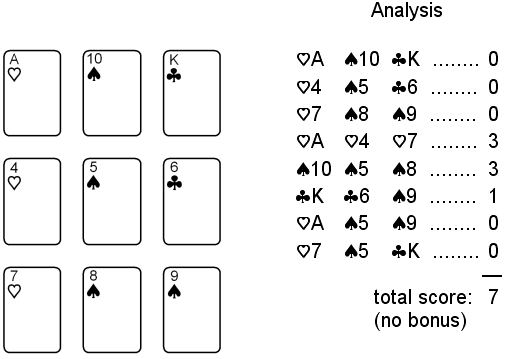
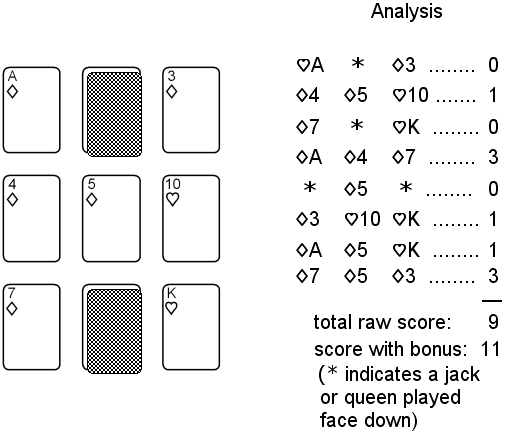
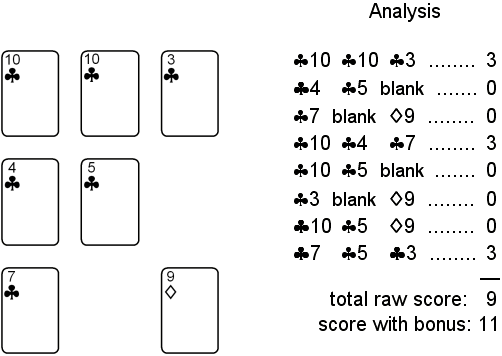
| ||
|
If you have played the original game of Leopard, you might be a little confused by the rules presented here. You will realize that something is different, but you may not know exactly what. So I should explain the changes I made (and why). In the original game, you got 1 point for a row of three cards of the same color, but you got only 2 points for a row of the same suit. I noticed that players mostly tried to get rows of the same color. When that resulted in some rows of the same suit, then that was fine. However, they usually didn’t think it was worth the extra effort (or turns) to get cards of the same suit (and they were probably right). I increased the score for a row of the same suit from 2 to 3, hoping that would make the suits a bigger part of the game. Having two goals, both suits and color, will add complexity to the game. Because I increased the score for suits, I increased the score needed to go out from 5 to 7. I also changed the bonus to double every point above 7 (instead of every point above 5). Actually, I questioned whether this bonus was a good idea, and I was tempted to drop it, but I didn’t want to make a change like that without a lot of testing. Besides, some of these things are almost impossible to test. In the original game, the squares were numbered The original game had a four-player, partnership version. I doubt that anyone played it, and I decided to drop it from the version on this site.
| ||